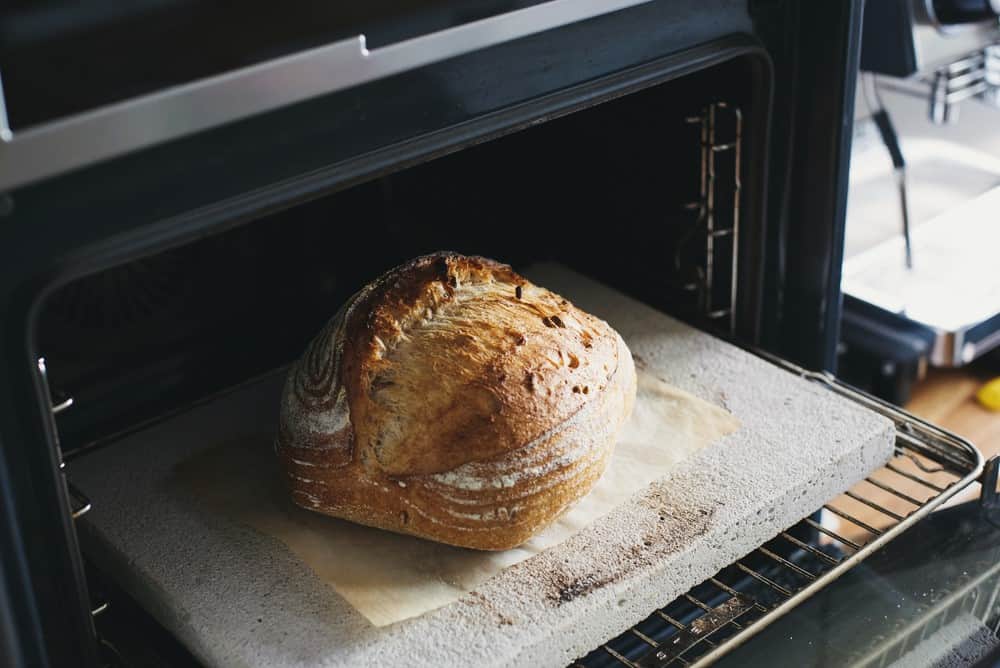We may earn money or products from the companies mentioned in this post.
(Last Updated On: August 29, 2023)Wondering how you can achieve that golden brown, all-over crispy crust for your beautiful sourdough bread? A baking stone is a simple, low-cost baking tool that can mimic the conditions of a brick oven, bringing your bread to the next level.
These stones are typically made of cordierite, can withstand over a thousand degrees, and are designed to replicate the conditions of a brick oven. Because of their size, you can easily bake 2 loaves of artisan bread at a time.
By using a baking stone, you can achieve perfectly crusty, evenly baked, and delicious artisan breads that closely resemble those made in traditional brick ovens!
Are you drooling yet?
Understanding Baking Stones
Baking stones (also known as pizza stones) are a popular piece of bakeware for many home chefs who want to achieve bakery-quality bread and pizza at home. The neat part about these stones is that they have a porous surface that absorbs moisture from the dough and helps create a crispy, evenly cooked crust.
Using a baking stone is easy, you just place it on the bottom or middle rack of your oven before preheating. Allow the oven to reach its desired temperature and give the stone plenty of time to heat up, usually at least 30-45 minutes. This helps the stone to achieve even heat distribution, ensuring excellent cooking results for your bread or pizza.
Best OVerall Bread Stone
HANS GRILL PIZZA STONE
The Hans baking stone is made of toughened porous cordierite stone, which makes it FDA safe and heat resistant up to 1112°F. It is perfect for baking artisan bread, pizza, pies, pastry, and even frozen pizzas!
The stone distributes heat evenly for the perfect browned bread or crispy pizza crust! Considering it’s typically under $40, this is a great option if you’re wanting to bake openly but still have nicely browned, crisp crust that is perfectly cooked inside.
Runner up bread Stone
Unicook Pizza Stone
The Unicook Stone has fantastic reviews, and is a reliable option for baking delicious breads and pizzas. Its natural cordierite construction is heat resistant up to 1450°F (not that you’ll ever need it that hot!).
Its porous structure allows for even heat distribution and efficient moisture extraction, resulting in crispier crusts! No more soggy bottoms 🙂
Other Uses of Baking Stone
Besides using it for sourdough, you can use your baking stone for different types of flatbreads such as pita, naan, and tortillas. The even heat provided by the stone will help you achieve that perfect thin, crispy texture on the outside while keeping the inside soft and tender.
If you’re a fan of making baguettes, your baking stone can help achieve the crispy crust and airy, soft interior that you desire. The stone’s consistent heat helps in forming a well-cooked crust while maintaining an even bake for the entire loaf.
Grilling enthusiasts can also make good use of a baking stone. Place it on your grill to create an evenly heated surface for cooking not only pizzas but also delicate foods that might stick or fall through the grates. This works great for cooking marinated vegetables, fish fillets, and shrimp.
Although we haven’t tried it, some people swear that switching from a standard baking sheet to a baking stone can even improve the quality of your homemade cookies, too!
Caring for Your Baking Stone
Caring for your baking stone is essential in order to maintain its quality and ensure perfect bread baking. By taking good care of it, you can prolong the life of your stone.
First, always preheat your stone before using it. This is important for even baking as it helps to avoid under- or over-cooking the bread. For a ½ inch thick stone, preheat it for 30 minutes, while for a thicker stone (¾ – 1 inch), preheat for up to an hour.
In terms of cleaning, it is important to be gentle with your baking stone. Do not use harsh chemicals, as this may damage the surface. Instead, use a scraper to remove any excess food and brush off any crumbs.
If you have an unglazed stone, refrain from using soap, as it can get absorbed into the stone, leaving a soapy taste behind. For both glazed and unglazed stones, cleaning with warm water and a soft brush or cloth is recommended.
One of the most common issues with baking stones is cracking. To prevent this, avoid sudden temperature changes or direct contact with water while the stone is hot. Also, never place a cold stone in a hot oven or put cold ingredients directly on a hot stone. This can cause thermal shock, which may result in cracks or breakage.
Dealing with Common Issues
Heat retention is one of the key aspects of a baking stone. You need to preheat the stone in the oven for at least an hour before baking to ensure even and effective heat transfer. This will give you that crispy texture on the exterior of your bread while keeping the inside soft and moist. Keep your oven temperature high, around 500°F (260°C) or more, for optimal results.
Sometimes, a baking stone may experience thermal shock, causing it to crack or shatter. This happens when there is a sudden temperature change, such as putting a cold stone into a hot oven or placing a hot stone on a cold surface. To avoid this issue, make sure your stone is at room temperature before preheating it in the oven. Also, avoid placing hot stones on cold countertops.
The porous nature of some baking stones can result in a slight absorption of water and flour over time. To prevent your dough from sticking to the stone, always dust it with a thin layer of flour or cornmeal before placing your dough on it. This will also contribute to a crispy texture on the bread’s bottom.
If you’re concerned about your stone cracking, you can take some precautions. When using a metal pan, such as a pizza pan or a cookie sheet, place a room-temperature stone on the bottom rack of your oven. The pan will help distribute heat evenly throughout the stone, reducing the risk of cracking.
Lastly, it is essential to handle your baking stone responsibly. Do not pour water onto a hot stone, as the rapid temperature change can cause damage. Allow the stone to cool down before cleaning it, and when cleaning, avoid using any soapy water that could penetrate the stone’s surface. Instead, use a dry brush or a damp cloth to remove any residue gently.
Additional Baking Stone Equipment
A peel is an essential tool for transferring your bread dough onto the hot baking stone. It resembles a large, flat spatula with a long handle, usually made of wood or metal. Using a peel will prevent burns and ensure your dough is placed safely and accurately onto the stone.
Parchment paper can be useful when working with a baking stone as well. You can place the dough on a piece of parchment paper before transferring it to the preheated stone. Using parchment paper has the added benefit of making it easier to remove the baked bread without damaging the crust.
If you’re looking to create a steamy environment for your bread without using a baking stone, consider using a Dutch oven. This versatile piece of cookware can effectively mimic the moisture-retaining abilities of a baking stone, resulting in a crispy crust and tender interior.
A cloche, or bell-shaped cover, can be used in combination with a baking stone to trap steam and promote even baking. The cloche works similarly to a Dutch oven, but with the advantage of being able to observe your bread while it bakes.
If you don’t have a dedicated baking stone, you can replicate a similar effect by using bricks. Simply line the bottom of your oven with unglazed, clean bricks, preheat them as you would a baking stone, and use them for baking your bread.
By incorporating these additional pieces of equipment and methods, you can enhance your bread-baking experience and create delicious, perfectly baked loaves every time.





